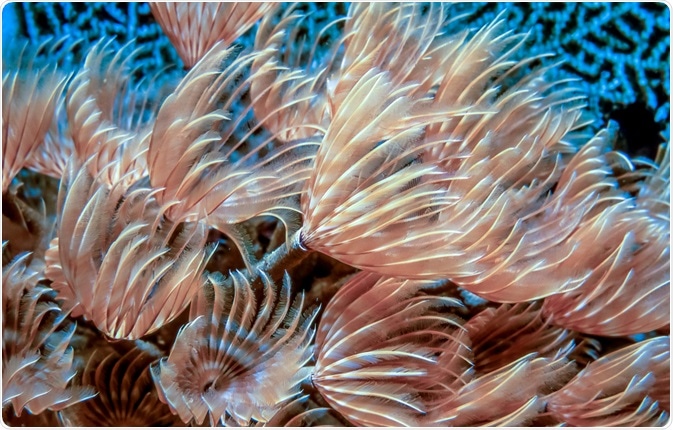Bacterial infections were a leading cause of death until the advent of antibiotics. The treatment of a wide variety of such infections using antibiotic drugs was rightly regarded as a major medical breakthrough. However, after widespread overuse of these agents, it now appears that this achievement may not be sustainable in the future, as bacteria have acquired resistance to many antibiotics.
In this case study, researchers discovered a novel agent with antibiotic properties within the mucus of M. infundibulum, a parchment tube worm that lives in a marine environment. The structure of the compound was identified using NMR spectroscopy.
 Image Credit: John A. Anderson / Shutterstock.com
Image Credit: John A. Anderson / Shutterstock.com
Consequently, many antibiotics, including those previously considered to be among the most efficacious, have been rendered inactive against several bacterial pathogens. Infection is thus becoming a major cause of morbidity and mortality once again.
In order to reverse this trend, there is a renewed focus on the development of novel antibiotics. Although antibiotics were originally discovered from natural sources, many modern antibiotics have been generated using synthetic biology methods to achieve greater efficacy and improve yields. With a real risk of returning to a pre-antibiotic era, researchers are once again looking to nature for inspiration to inform the development of new antimicrobial agents1.
One line of research in this area is the protective mucus secreted by a range of invertebrate organisms.
Invertebrate mucus
Several marine invertebrates coat themselves with a slippery external surface coating of mucosal matrices2. These comprise a network of polysaccharides and proteins entangled to form a weak gel and exhibit a diverse range of properties according to the specific needs of the organism. In addition to providing mechanical and osmotic protection, the mucus can contain molecules that are bitter tasting, poisonous, or irritating to deter predators2.
Polychaetes, also known as bristle worms, are marine invertebrates from the annelid class. Mucus secretion is very widespread across this invertebrate group and is produced in multiple forms of varying elasticity and viscosity. The structural properties of mucus are typically determined by the nature of the glycoproteins, known as mucins, present3.
The mucus has also been found to include various entities with antibiotics or antioxidant activity4 and immunomodulators5. In particular, lysozyme-like activity has been reported in various polychaete species6.
Lysozymes are enzymes that catalyze the hydrolysis of the β1–4 glycoside bond between N-acetylmuramic acid (NAM) and N-acetylglucosamine (NAG). Since this activity damages the bacterial cell wall, the presence of lysozymes provides invertebrates with non-specific innate immunity against bacterial invasion.
Much of the lysozyme research to date has focussed on the main body cavity, known as the coelom. Researchers have now investigated the presence of lysozyme-like activity in the mucus7.
Advanced NMR techniques provide an in-depth characterization of mucus
Antimicrobial lysozyme-like and antioxidant activities of the mucus of the Mediterranean polychaete Myxicola infundibulum have recently been investigated7. This species was selected as it secretes copious amounts of mucus. Furthermore, since the worm is extremely slow-moving, it is especially vulnerable to microbial colonization, and so the mucus is likely to contain antimicrobial agents.
The mucus of M. infundibulum was initially chemically characterized in terms of elemental composition, and the relative protein, lipid and carbohydrate composition. A more detailed analysis was then obtained using multinuclear and multidimensional nuclear magnetic resonance (NMR) spectroscopy to determine the presence of bioactive compounds with antimicrobial and antioxidant activities.
The mucus samples of M. infundibulum were characterized by 1H and 13C 1D NMR as well as heteronuclear single quantum coherence (HSCQ) spectroscopy and 2D NMR using a Bruker Avance III 400 MHz spectrometer.
The mucus was shown to be mainly composed of water. The dry weight had a high concentration of inorganic elements, notably chloride and sodium. It is likely that this is a result of dried salts being left over when seawater in the mucus evaporates. Proteins were the most prevalent organic component of the dry weight, but lipids and carbohydrates were also present.
NMR spectroscopy revealed that the small lipid component was largely of alcoholic origin and that the most abundant amino acids making up the protein component were valine, leucine, and alanine. In addition, NMR analysis identified the presence of pyroglutamic acid that forms spontaneously from the amino acid L-glutamate, further confirming the protein content of the mucus.
The mucus was shown to exert a natural antibacterial lysozyme-like activity (which was equivalent to 1.14 mg/mL of hen egg-white lysozyme) and an antioxidant activity, which was shown by Trolox Equivalent Antioxidant Capacity (TEAC) assay to be 483.00 nmol TE/mL (Trolox equivalent/mL).
The lysozyme activity recorded in M. infundibulum mucus was restricted to one of the seven major protein bands. Interestingly, this was shown to be a known adhesive marine protein.
This study highlights the potential interest of the mucus from marine invertebrates as a potential source of bioactive compounds for biotechnological applications.
The authors propose that further research should be conducted with M. infundibulum mucus to discover novel antibacterial agents. In addition, the natural antioxidants present in the mucus may also be useful for promoting human health.
References
- Wright GD. Nat. Prod. Rep 2017;34:694-701.
- Derby CD. Biol. Bull. 2007;213:274–289.
- Bansil R, Turner BS. J. Colloid Interface Sci. 2006;11:164–170.
- Conley KR, et al. Proc. Biol. Soc. B 2018, 285, 20180056.
- Iwanaga S, Lee BL. J. Biochem. Mol. Biol. 2005;38:128–150.
- Zapata Vivens E, et al. Cienc. 2005;31:1–10.
- Stabili L, et al. Mar. Drugs 2019;17:396. doi:10.3390.
About Bruker BioSpin

Bruker BioSpin offers the world's most comprehensive range of NMR and EPR spectroscopy and preclinical research tools. Bruker BioSpin develops, manufactures and supplies technology to research establishments, commercial enterprises and multi-national corporations across countless industries and fields of expertise.